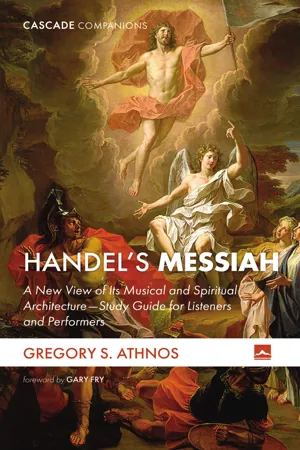
Handel's Messiah
A New View of Its Musical and Spiritual Architecture—Study Guide for Listeners and Performers
- 156 pages
- English
- ePUB (mobile friendly)
- Available on iOS & Android
Handel's Messiah
A New View of Its Musical and Spiritual Architecture—Study Guide for Listeners and Performers
About this book
We think we know Handel's Messiah, having heard it or performed it so many times. But is there another way to look at this masterpiece? Who assembled the texts? Why? How did Handel incorporate his own spiritual understanding of the texts? In this treatise, we view the composition from the same Baroque aesthetic perspective the composer used: the Doctrine of Affections--an approach heretofore unexplored in relationship to Handel's Messiah--which held that every major and minor key prompted a particular, very specific, and involuntary emotional and spiritual response in the listener. When facing a choice between following the accepted rules of musical composition or using the Affect best suited to the scriptural text, Handel almost exclusively chose the Affect; in other words, he chose spiritual insight over compositional tradition. Overlaying the various Affects on each movement of Handel's composition, we discover the true heart and spiritual depth of the composer's magnum opus.
Frequently asked questions
- Essential is ideal for learners and professionals who enjoy exploring a wide range of subjects. Access the Essential Library with 800,000+ trusted titles and best-sellers across business, personal growth, and the humanities. Includes unlimited reading time and Standard Read Aloud voice.
- Complete: Perfect for advanced learners and researchers needing full, unrestricted access. Unlock 1.4M+ books across hundreds of subjects, including academic and specialized titles. The Complete Plan also includes advanced features like Premium Read Aloud and Research Assistant.
Please note we cannot support devices running on iOS 13 and Android 7 or earlier. Learn more about using the app.
Information
Table of contents
- Title Page
- Introduction
- Chapter 1: The Baroque Doctrine of the Affections
- Chapter 2: Charles Jennens, Deism, and the Enlightenment
- Chapter 3: George Frideric Handel
- Chapter 4: Charles Jennens’ Scripture Collection
- Chapter 5: Oratorio Musical Components
- Chapter 6: Compositional Devices
- Chapter 7: Scene 1: The World after the Fall
- Chapter 8: Scene 2: The Promise
- Chapter 9: Scene 3: Shaking up the World
- Chapter 10: Scene 4: First Words of a Virgin Birth
- Chapter 11: Scene 5: Into the Shepherds’ Field
- Chapter 12: Scene 6: Four Images of a Savior
- Chapter 13: Scene 7: Redemption through Personal Suffering
- Chapter 14: Scene 8: Prophecies of Death and Resurrection
- Chapter 15: Scene 9: From Resurrection to Ascension
- Chapter 16: Scene 10: The Gospel Is Preached
- Chapter 17: Scene 11: The Resurrected Messiah Defeats the Enemies of God
- Chapter 18: Scene 12: In Response, the Believers Sing
- Chapter 19: Scene 13: Homage to the Triumphant Savior
- Chapter 20: Scene 14:Resurrection Hope
- Chapter 21: Scene 15: The Conclusion of the Apostle Paul’s Words to Corinth
- Chapter 22: Scene 16: Around the Throne of the Lamb
- Conclusions